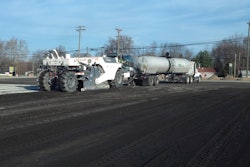At the recent 2006 National Conference on Materials and Energy Conservation for Hot-Mix Asphalt in Indianapolis, both asphalt producers/contractors and their state agency customers were encouraged to work together to increase the levels of reclaimed asphalt pavement (RAP) in hot-mix designs. Increasing RAP offers the best solution for addressing ever-rising material costs.
But here's the glitch. Road agencies are hesitant to increase RAP content in the mix designs they're specifying for highway projects because they've had some bad experiences with projects that have not performed. Following the oil shortage of the '70s, recycling asphalt pavements began to evolve and RAP content increased, but DOT's were beginning to experience rutting problems by the mid-1980s. It was determined that the rutting was a result of the low in-place air voids and high dust content associated with the amount of RAP being used. Mix designs with lower RAP content were then specified and new Superpave designs of the '90s further reduced the amount of RAP in order to meet the VMA (Voids in the Mineral Aggregate) criteria.
Superpave and subsequent polymer modified asphalts have restricted RAP usage to 10 to 15 percent. On average, highway asphalt projects across the country contain approximately 12 percent RAP. There's no reason why those projects couldn't contain 30 to 40 percent.
With rising liquid asphalt binder and aggregate prices, the industry needs to take another look at increasing RAP levels. That means asphalt producers/contractors who want to supply mixes with 20 percent or more RAP content will have to prove that those mix designs will perform as well or better than mixes with limited RAP usage. Once RAP content goes above 20 percent, it's difficult to quantify the exact composition— aggregate, fines and liquid asphalt, which can all adversely affect the required VMA of a mix design. The quantity of fines starts to vary significantly, which can affect the required VMA requirement. The fines also contain more liquid AC, which can also impact the placement and performance quality of the mix.
So how do you increase the RAP content of mix designs and guarantee performance? Fractionate the RAP material you want to use. Virgin aggregate material is white rock and RAP is black rock— black rock is the same as white rock; it just has a coating of AC. So if you screen your RAP into separate piles of sized material, just as you do with virgin material, you can then incorporate specific quantities of RAP aggregate and fines, and better determine the AC content of both, into the mix designs that meet the required VMA criteria for placement and performance.
With proof of performance, road agencies can then feel confident that the higher RAP content of mix designs can and will perform as specified. And with piles and miles of black rock readily available, it just makes sense for asphalt producers/contractors and their road agency customers to figure out a way to use more RAP.
Greg Udelhofen, Editor
















